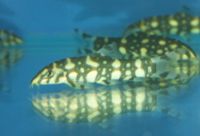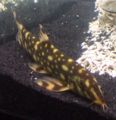Polka Dot Loach (Botia kubotai)
From The Aquarium Wiki
Polka Dot Loach
Botia kubotai
114 Litres (30 US G.)
10-12 cm (3.9-4.7")
Freshwater
6.8 - 8
24 -28 °C (75.2-82.4°F)
2-10 °d
1:1 M:F
3-4 years
Family
Cobitidae
Contents
Additional names
- Polka Dot Loach, Burmese Border Loach, Myanmar Botia, Clouded Botia, Marble loach, Polka Dot Botia, Botia "Angelicus", Angelicus Loach
Sexing[edit]
- No known way to tell externally.
Breeding[edit]
- They were not known to breed in captivity until recently. The secret it seems is to have them in a large tank with at least 10 others with plenty of bogwood with crevices so they can pair off and spawn.[1]
Tank compatibility[edit]
- These are quite a boisterous species and will do better with other Loaches even if not of the same species (e.g. Chromobotia macracanthus etc) They are sometimes known to bully smaller and weaker fish if not kept with other Loaches. They will eat fry so be care should be taken when breeding other fish around them. They can often be seen interacting with other fish of the same species.
Diet[edit]
- A non picky eater, sinking cat fish pellets are good for the staple diet and then they like to be fed live foods once or twice a week to keep them healthy. They will happily eat dried flake foods if any sink to the bottom of the tank.
- They like to have a well planted environment with bogwood so that they can graze on the leaves. If there is any algae available they may eat that but it is rare as they prefer the plants. It is important that they get enough vegetables in their diet and so it would be a good idea to provide vegetables about once a week.
- Suitable vegetables include lettuce, courgette, cucumber, spinach, some will eat more obscure things like broccoli or sprouts. To prepare these, they need to be softened by placing them in water in the microwave or by boiling for about 2 minutes in a saucepan.
- When this fish is enjoying it's food, a clicking sound can be heard like with other Loaches.
Feeding regime[edit]
- They should be fed like any other fish: 2-4 times daily in small amounts. They can often be heard to make a clicking sound when they are enjoying their food.
Environment specifics[edit]
- Prefers a sandy substrate, or if kept on gravel then it needs to be very smooth to protect the barbels, and some hiding places including caves. They have been known to hide at the back of the internal filters of tanks.
Behaviour[edit]
- These fish can be quite timid when first introduced into the tank but they will soon come out more, especially when it's feeding time. Providing the fish with ample hiding spaces will make the fish feel more secure and therefore the fish will be out more often. The fish tend to stay on the bottom of the tank. These fish are incredibly social and can often be seen interacting in their groups.
Identification[edit]
- This type of Loach is easy to identify by the spots on it. There are no other Loaches like it. Juveniles have markings that are more like stripes and these merge together as the fish gets older.
Pictures[edit]
References[edit]
- ↑ PFK Online August 2008 - Breeder Mark Duffill from Middlesborough in the UK.
External links[edit]
- Fishbase (Mirrors:
 )
)
- Loaches Online
- PFK Article - Free subscription required.
- Animal World
- Wikipedia
- PFK Article - A fishkeeper's guide to botiine loaches.
- Aquahobby - Burmese Border Loach.
- Aquatic Community
- Badmans Tropical Fish


